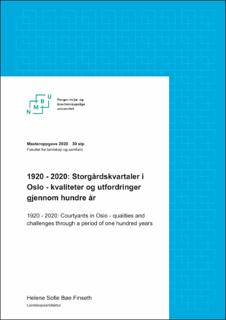| dc.contributor.advisor | Lindheim, Tone | |
| dc.contributor.author | Finseth, Helene Sofie Bøe | |
| dc.coverage.spatial | Norway, Oslo | en_US |
| dc.date.accessioned | 2021-03-05T12:57:49Z | |
| dc.date.available | 2021-03-05T12:57:49Z | |
| dc.date.issued | 2021 | |
| dc.identifier.uri | https://hdl.handle.net/11250/2731894 | |
| dc.description.abstract | Det er omtrent hundre år siden den kommunale boligbyggingen i Oslo startet. Masseutbygging og boligspekulasjon på slutten av 1800-tallet var noen av de utløsende årsakene til Kristianiakrakket i 1899, som førte til en svært utfordrende boligsituasjon i hovedstaden. I 1910 uttrykte sjefen for kommunens statistiske kontor «at man er kommed ned i et forhold, som uten tvil maa karakteriseres som bolignød». Dette førte blant annet til opprettelsen av Det Kommunale Boligkontor i 1914 som skulle sørge for å løfte beboere ut av trangboddhet og mørke gårdsrom gjennom kommunal boligbygging. Arkitekt og byplanlegger Harald Hals (1876-1959) var en av flere som stod i spissen for denne utviklingen, og resultatet ble fullendte boligstrøk inspirert av internasjonale bevegelser. Ved siden av å tilføre et betydelig antall boliger, ble også byens gatebilde og gårdsrom endret som følge av utviklingen.
Denne oppgaven tar for seg en historisk gjennomgang av forholdene som førte til den kommunale boligbyggingen, og tre påfølgende byplanidealer. Fire caser blir deretter belyst gjennom en historisk introduksjon, tolkning av historiske foto og funn fra registeringer og observasjoner av dagens situasjon. Strøkene som undersøkes er Torshovbyen, Jessenløkken, Ullevål hageby og Lindern hageby som ble utviklet under innflytelse av Harald Hals i perioden rundt 1920-tallet. Oppgaven dykker så dypere ned i Lindern hageby, hvor historisk og eksisterende situasjon sammenlignes.
Til slutt fokuserer oppgaven på et av kvartalene i Lindern Hageby, nemlig kvartal I, som var det Kommunale Boligkontorets aller første prosjekt. I utgangspunktet virker gårdsrommets overordnede struktur i dag å være relativt lik som den var i 1920-årene, men ved en nærmere analyse av fotografier og gjennom observasjon, ser man at det også er en del som er endret. Det har trolig skjedd som en følge av større endringer i beboernes levemåte og livsstil. Avslutningsvis undersøker oppgaven ulike tiltak for bevaring eller forbedring som gjøres for å forbedre gårdsrommet slik at det tilpasses dagens utfordringer og behov. | en_US |
| dc.description.abstract | A hundred years has passed since the municipal housing development in Oslo started. Mass housing development and speculation at the end of the 19th century were some of the triggering causes of the Kristiania economic crash in 1899 which led to a very challenging housing situation. In 1910, the head of the municipal statistical office expressed “that one has come to a situation in which without a doubt must be characterized as a housing emergency” (my translation). As a result, Det Kommunale Boligkontor (the municipal housing office) was established in 1914 to ensure that residents were lifted out of cramped housing and dark courtyards through municipal housing. The architect and urban planner Harald Hals (1876- 1959) was one of several others who spearheaded this development. The result was large residential areas inspired by international movements. The municipal housing projects led not only to a significant number of new dwellings, it also changed the streets and the courtyards of the city.
This study presents a historical review of the conditions that led to the municipal housing development and three subsequent urban planning ideals. Further, four cases will be analysed through a historical introduction, an interpretation of historical photographs and eventually findings from registrations and observations of the current situation. The study examines three areas which are Torshovbyen, Jessenløkken, Ullevål hageby and Lindern hageby. They were all developed under the influence of Harald Hals in a period around the 1920s. Further, the thesis dives deeper into Lindern hageby where the historical situation is compared to the current situation.
Finally, the study focuses on one of the quarters in Lindern hageby, namely quarter I, which was Det Kommunale Boligkontor’s very first project. Initially, the overall structure of the courtyard today seems to be relatively similar to the structure that existed in the 1920s. However, observation and a closer analysis of photographs reveal several changes and differences. The changes in the courtyard are most likely a result of changes in the residents’ way of life. Further, the thesis examines and suggests different measures that can be taken to improve the courtyard to fit today’s challenges and needs. | en_US |
| dc.language.iso | nob | en_US |
| dc.publisher | Norwegian University of Life Sciences, Ås | en_US |
| dc.rights | Attribution-NonCommercial-NoDerivatives 4.0 Internasjonal | * |
| dc.rights.uri | http://creativecommons.org/licenses/by-nc-nd/4.0/deed.no | * |
| dc.title | 1920-2020 : storgårdskvartaler i Oslo : kvaliteter og utfordringer gjennom hundre år | en_US |
| dc.title.alternative | 1920-2020 : courtyards in Oslo : qualities and challenges through a period of one hundred years | en_US |
| dc.type | Master thesis | en_US |
| dc.description.localcode | M-LA | en_US |

